
Guests
- Gerald Horneprolific author and professor of history and African American studies at the University of Houston.
The prolific historian Gerald Horne joins us to discuss his new book that explores some of the themes of what is known as Black August. The Center for Constitutional Rights defines Black August as a time designated to commemorate and honor “the freedom fighters, especially those inside the walls of our sprawling prison-industrial complex, who, with their vision, tenacity, and deep love for our communities, are leading us toward the horizon of abolition.” Black August began in 1979 inside San Quentin State Prison in California in part to commemorate the anniversary of the death of imprisoned Black Panther George Jackson, who was shot and killed by guards during an escape attempt on August 21, 1971. The work of Jackson and others are examined by professor Gerald Horne in his new book, Armed Struggle? Panthers and Communists; Black Nationalists and Liberals in Southern California Through the Sixties and Seventies. The book also draws on Horne’s own experience in Berkeley in the ’70s. Horne is a professor of history and African American studies at the University of Houston and author of many books.
Transcript
AMY GOODMAN: This is Democracy Now!, democracynow.org, The War and Peace Report. I’m Amy Goodman, with Juan González.
As we approach the end of August, we’re joined by the author of a new book that explores some of the themes of what’s known as Black August. The Center for Constitutional Rights defines Black August as a time designated to commemorate and honor, quote, “the freedom fighters, especially those inside the walls of our sprawling prison-industrial complex, who, with their vision, tenacity, and deep love for our communities, are leading us toward the horizon of abolition,” end-quote.
Black August began in 1979 inside San Quentin State Prison in California in part to commemorate the anniversary of the death of the imprisoned Black Panther George Jackson, who was shot and killed by prison guards during an escape attempt on August 21st, 1971.
The work of Jackson and others are examined by professor Gerald Horne in his new book titled Armed Struggle? Panthers and Communists; Black Nationalists and Liberals in Southern California Through the Sixties and Seventies. The book also draws on Gerald Horne’s own experience in Berkeley in the '70s. He's a professor of history and African American studies at the University of Houston and author of many books.
Welcome back to Democracy Now! It’s great to have you with us, Professor Horne. Can you start off by talking about what motivated you to write this book? It’s Armed Struggle? with a question mark. It’s about 600 pages. Talk about your investigation and your experience.
GERALD HORNE: Well, my experience is that I arrived in Berkeley, Oakland, in the summer of 1969 to attend an important anti-fascist conference organized by the Black Panther Party. It marked a new departure in terms of the U.S. left, insofar as you had this radical Black movement, recently organized, the Black Panther Party, taking a leadership role in terms of the entire U.S. left — and to an extent, the global left, since it was an international conference.
A few months later, I moved to San Francisco — that is to say, in June 1970 — to attend law school. And a few weeks after that, you had the armed action at the Marin County Courthouse, north of San Francisco, where the precocious teenager Jonathan Jackson led an assault on the courtroom. The reason remains murky. One explanation is he was seeking to free his jailed brother, the aforementioned George Jackson. Another explanation was that he was seeking to get to a radio station in order to broadcast about the torturous conditions inflicted upon prisoners like his brother George Jackson. In any case, he was killed. A number of his comrades were killed, and a judge was killed.
This led to an attempt to convict his comrade, speaking of the professor still in the land of the living, Angela Davis, because the arms were traced to her. She went on the lam, eventually was captured in Manhattan, stood trial in California. This led to a mass movement, not only nationally, but internationally, which led to her freedom and led to her subsequent notoriety.
JUAN GONZÁLEZ: And, Gerald, this history of the Panther Party, especially in California, although the Panthers are often seen as an iconic — as iconic figures in the Black community, the level of their dedication to Marxism and socialist revolution is not really highlighted much. Could you talk about the impact they had, not only in the prisoners’ rights movement, but on the left generally in the United States at that time?
GERALD HORNE: Well, sadly and unfortunately, the histories of the Panthers have not necessarily kept faith with their orientation. They styled themselves as revolutionary Black nationalists, in contradistinction to those they termed cultural nationalists. Unfortunately, when they were liquidated about a decade or so after they were formed in 1966, the term and the movement, revolutionary Black nationalism, tended to be liquidated alongst with them.
This is quite unfortunate, because what the Panthers sought to do was quite remarkable. They had an international legation in Algeria. They sent delegations frequently to the nation then known as the People’s Republic of the Congo, Congo-Brazzaville, as distinct from the larger Congo across the Congo River, Congo-Kinshasa. They had a liaison with the Palestine Liberation Organization and met repeatedly with revolutionaries from Palestine, including Yasser Arafat, not to mention revolutionaries from the African continent, including Amílcar Cabral of Guinea-Bissau. So, that kind of internationalism was unique, to a degree, to the Black Panther Party.
And when they were subjected to dirty tricks by the U.S. government, COINTELPRO, the Counterintelligence Program; when they were killed in their beds, as happened to Fred Hampton, for example, not to mention his comrade Mark Clark, who was killed along with him in Chicago in December 1969; when they were driven into exile; when they were imprisoned, with some still in prison to this very day, unfortunately, this did not allow for a sober estimate of all they were trying to accomplish.
JUAN GONZÁLEZ: And in terms of their connection to more traditional socialist or communist organizations — for example, the Che-Lumumba Club of the U.S. Communist Party was largely based, as I recall, in Los Angeles — what kinds of connections did they have with the Panther leadership at that point?
GERALD HORNE: Well, Angela Davis was a member of Che-Lumumba, and she was a kind of bridge between the Black Panther Party and the U.S. Communist Party. Angela Davis also was involved in the movement to free Panther Chairman Bobby Seale.
The Black communist leader William Patterson, who was born in San Francisco in the 1890s, led the movement to free the Scottsboro Nine in Alabama in the 1930s — once again, a global and domestic movement, that was a first and initial blow against Jim Crow — he subsequently became a leader of the movement to free Angela Davis, not to mention a counselor to the Black Panther Party. The founder of the Black Panther Party, speaking of Huey P. Newton of Oakland, California, when he was growing up in the Bay Area in the 1950s, he admits that he was deeply influenced by the organization then led by Patterson, speaking of the Civil Rights Congress, which was also bolstered into significance by Patterson’s comrade, the late great Paul Robeson.
So, there were many interlocking relationships between the Panthers and the U.S. communists, not to mention the fact that George Jackson himself, in his correspondence with the late communist historian Herbert Aptheker, the author of a still-important and profound study of slave revolts in the United States — George Jackson said that he wanted to be seen as the Black face of socialism. His precocious younger teenage brother, speaking of Jonathan Jackson, as a 17-year-old at a high school in Pasadena, California, he edited a newsletter that carried the title Iskra — I-S-K-R-A — which was homage to a journal of the same name that was published by Soviet Bolsheviks in the 1917 era. So, unfortunately, this kind of history, perhaps because of how the Cold War eventuated, has been buried. And I’ve tried to revive it.
JUAN GONZÁLEZ: I recall back many years after the Panthers had effectively been destroyed, The New York Times had a front-page story that the FBI had conducted its own public opinion poll privately and discovered that over 25% of all African Americans in the United States were supporting the Black Panther Party. To what degree do you think the mass support that the Panthers had among the masses of Black people drove the COINTELPRO efforts of J. Edgar Hoover to destroy the organization?
GERALD HORNE: Well, I think that this was very significant. And this support in the Black community was also emblematic of the point that the Panthers had an analysis of Black suffering that struck a chord within the Black community. And unfortunately, the kind of analysis that they represented once again was buried and/or liquidated as they were buried and/or liquidated.
What I mean is that the Panthers suggested, particularly George Jackson, that there were fascist-like conditions being visited upon the Black community. And as we survey the landscape today and recall Michael Brown in Ferguson, Missouri, Sonya Massey in Springfield, Illinois, Sandra Bland in Southeast Texas, Eric Garner in Staten Island, New York, and the sickening litany of Black victims of police violence — that is to say, Black people executed at the hands of the state — this can fairly be seen as an emblem of fascist-like conditions, and, indeed, it’s an extension, in a sense, of slavery, insofar as slavery in this country was generally reserved for those of African descent.
And so, with the abolition of slavery, you basically had a migration of the kind of anti-Blackness and genocide-like conditions descending to this very day. And the Panthers sensed that. That was part of their makeup, ideologically, that helped to infuse their Ten-Point Program. And once again, it helped to enrage the authorities, like the pugnacious J. Edgar Hoover of the FBI, to launch a crusade of persecution against them.
JUAN GONZÁLEZ: And the split that developed early on between the cultural nationalist movement, represented by Ron Karenga, and the Panthers itself, could you talk about that a little bit, especially for younger viewers and listeners that may not be familiar with that history?
GERALD HORNE: Well, there were ideological cleavages within the Black movement that were centered, to a degree, in Los Angeles. The aforementioned Mr. Karenga, of course, was sited in Los Angeles. This came to a boiling point in July 1969 at the campus of UCLA, when there was a shootout between so-called cultural nationalists and the revolutionary Black nationalists embodied in the Black Panther Party. Killed were John Huggins and Bunchy Carter, two leaders of the L.A. Black Panthers. This kind of murder was not only reflective of a deeper ideological cleavage, it was also reflective of the attempts, once again, by the FBI to stir rancor and resentment between and amongst various factions within the Black community. But once again, once the Panthers were wiped away from the scene as a result of the fact that they became a major target of the authorities, they were seen as a primary danger to the status quo in the United States, not least because of their internationalism, not least because of their analysis. This led, I’m afraid to say, to a burying of their legacy.
I should make one more point, as well, with regard to the Panthers and the broader U.S. left. That is to say, implicit in the Panther message was that the Black community, being a descendant of the unpaid sector of the working class, were an emblem of class struggle. You had to be involved in class struggle as an unpaid worker. I mean, for example, under the law of a number of states, if you walked away from the plantation, this could subject you to the death penalty. However, sadly and unfortunately, the U.S. left has taken an analysis that does not necessarily see slavery and genocide against Native Americans as foundational to the U.S. project. They see it as inimical to the U.S. project. And that was a kind of conflict, ideological conflict, that was underlying some of the rifts within the U.S. left and the Panther left. And those sorts of rifts have not been addressed sufficiently to this very day.
AMY GOODMAN: Gerald Horne, there’s so much that does not get covered in regular history books of the Black Panthers and communist history. You’ve done a remarkable job in covering this now. I wanted to read from a CBS report. This past May was the 57th anniversary of the 1967 Black Panther protest at California’s state Capitol. And it says, “May 2 marked the 57th anniversary of one of the most spectacular protests in California State Capitol history. The Black Panthers entered the capitol building armed with guns in protest. Entering the capitol with an open-carry gun was not against the law then. That changed quickly. Video from that day shows the scene. Black Panthers in their trademarked berets and leather jackets carried handguns and shotguns through the halls of the capitol.” Now, this led Governor — Governor Ronald Reagan, who was not exactly known as a gun control advocate, to quickly sign off on gun control legislation. Explain what was the rationale for this protest. And what happened next? And then, also, how many Black Panthers were murdered?
GERALD HORNE: There were dozens of Black Panthers, conservatively speaking, who were murdered.
The purpose of that May 1967 protest was to display what I term, and what many others have termed, armed propaganda. I think you have to draw distinction between and amongst armed propaganda, armed self-defense and armed struggle.
Armed propaganda was displayed, once again, in Sacramento. That is to say, this was an attempt to impress upon the authorities the strength and the mettle of the Panthers, which, of course, was displayed sufficiently.
Then there was armed self-defense. Recall what happened in December 1969, when the Panthers headquarters in Los Angeles was assaulted by the authorities. Because of the defenses prepared by then-Panther leader, then known as Geronimo Pratt, subsequently known as Geronimo Ji-Jaga, the Panthers were able to survive that brutal encounter and live to struggle and fight another day.
And then there’s armed struggle, which we’ve already talked about in terms of what happened at the Marin County Courthouse in August 1970. This kind of militancy was a direct descendant of the kind of militancy that led, fortunately, to the overthrow of slavery by 1865. I’m referring to what happened in what is now West Virginia in October 1859 when John Brown led an armed uprising against enslavement. I’m referring to what happened in Southampton, Virginia, in 1831 when Nat Turner led an armed uprising against slavery. The Panthers saw themselves as lineal descendants of John Brown and of Nat Turner. And there are historians, like myself, who tend to agree with them.
JUAN GONZÁLEZ: I’m wondering if you could talk a little about the lessons for today and the radical and revolutionary movement these days. For example, the U.S. government is — right now has arrested the members of the Uhuru Movement, who are facing up to 10 to 15 years in prison because the government alleges they acted as Russian agents after they criticized U.S. interference in Ukraine. Your sense of how the spirit of the Panthers lives on in movements today?
GERALD HORNE: Well, certainly, the Uhuru Three are a lineal descendant of the militancy of the Panthers, exemplified in the 1960s and the 1970s, particularly with regard to internationalism, because internationalism is the missing element in many of our struggles today. And I think the fact that the Uhuru Movement is being brought into the halls of injustice because of their objections to U.S. foreign policy, this is a signal that they are seeking to carry on the tradition, not only of the Panthers, who, once again, had an international legation in Algeria, who sent delegations to North Korea, North Vietnam, the Soviet Union, etc., but it’s also a reflection of the struggles spearheaded by the late great Paul Robeson and his Civil Rights Congress, which filed a petition at the United Nations in 1951, 1950, charging the United States with genocide against Black people. This kind of international pressure ultimately led to a retreat from the more egregious aspects of U.S. apartheid, speaking of Jim Crow.
And so, one of the reasons why you do not see the kind of internationalism as displayed by the Uhuru Movement and Chairman Omali is precisely because it tends to bring persecution in its wake. But I’m afraid to say that there is no eluding the fact that if we are to escape from the horrors of these fascist-like police killings, not to mention the crisis of everyday living, we’re going to have to see more of a display of the kind of internationalism that is now being brought into court as a result of the activism of the Uhuru Movement and Chairman Omali.
AMY GOODMAN: Just to explain, the Uhuru Three are the Chairman Omali Yeshitela of the African People’s Socialist Party; Penny Hess, chairwoman of the Africa People’s Solidarity Committee; and Jesse Nevel , chair of the Uhuru Solidarity Movement. But I wanted to go back in time, as we begin to wrap up, and ask you about Angela Davis and her significance today. You write, “After Angela Davis was found acquitted, the mass support she received from African Americans and from the international community was a combination that potentially could overcome the formidable right-wing forces that were ascending in the Republican Party and influencing the entire political spectrum.” That’s from your book, Armed Struggle? Can you talk about the significance of Davis’s trial and acquittal? And then talk about politics in the United States today, with possibly the first African American woman ascending to the presidency.
GERALD HORNE: Well, certainly, Angela Davis has been a profoundly important figure, from her days at the University of California, San Diego as a graduate student leading struggles on behalf of affirmative action, on behalf of diversification of the faculty and the student body, to her days as a junior professor at UCLA, where she confessed to being a member of the U.S. Communist Party, which led to a very important struggle over civil rights and civil liberties, to her trial in Northern California in the early 1970s, which, once again, led to an international movement and catapulted her into global headlines.
Today, of course, we face a very difficult political struggle in the United States of America. Polls suggest that it’s possible once again for the Democratic candidate, speaking of Vice President Harris, to win the popular vote but not prevail in the Electoral College. According to the Harris campaign itself, there are only about seven states in play seriously. We already know, for example, that the Democrats will likely prevail in California, Republicans will likely prevail in Texas, where I am now sitting.
And so, this opens up an opportunity for other progressive candidates to try to make their mark in those 43 states where we already know what the result is, and begin the long march of trying to build an anti-imperialist movement, a pro-peace movement, a movement based on international solidarity. It’s no secret that I’m a supporter of the campaign of Cornel West and Melina Abdullah, but I also take my hat off to the campaign of Dr. Jill Stein and Butch Ware, her vice-presidential candidate, who also happens to be a friend of mine, and other candidates of the progressive and radical left. So, this is the state of play we face as we stare ahead at the election.
AMY GOODMAN: Well, I want to thank you so much, Gerald, for joining us. Professor Gerald Horne is professor of history and African American studies at the University of Houston, author of many books, including Confronting Black Jacobins: The U.S., the Haitian Revolution, and the Origins of the Dominican Republic. His new book, just out, is titled Armed Struggle? Panthers and Communists; Black Nationalists and Liberals in Southern California Through the Sixties and Seventies. You can see all of his interviews over the years at Democracy Now! at democracynow.org. I’m Amy Goodman, with Juan González, for another edition of Democracy Now!

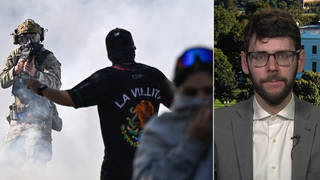
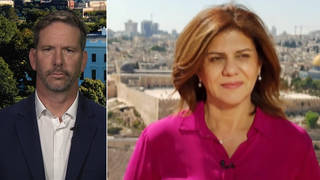
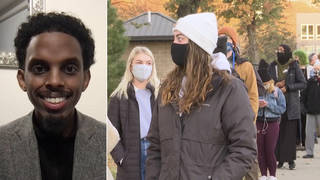
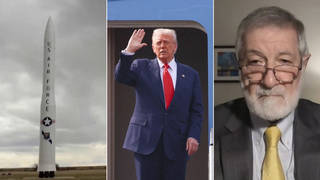





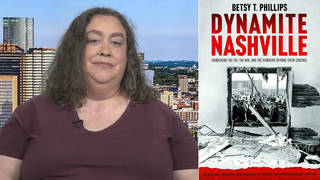
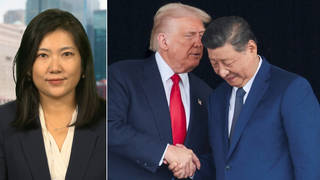
Media Options